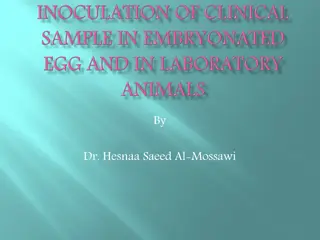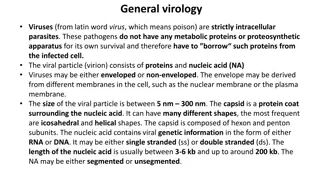
Medical Importance of Viruses: Hepatitis A Seminar Presentation
Explore the medical significance of viruses with a focus on hepatitis A, a common viral disease in Africa. Learn about the causes, symptoms, and history of hepatitis A, its impact on the liver, and the hepatitis A virus itself. Discover the functions of the liver and the terms associated with hepatitis, including acute and chronic infections. Uncover the characteristics of the hepatitis A virus, its discovery, and its impact on human health.
Download Presentation

Please find below an Image/Link to download the presentation.
The content on the website is provided AS IS for your information and personal use only. It may not be sold, licensed, or shared on other websites without obtaining consent from the author. If you encounter any issues during the download, it is possible that the publisher has removed the file from their server.
You are allowed to download the files provided on this website for personal or commercial use, subject to the condition that they are used lawfully. All files are the property of their respective owners.
The content on the website is provided AS IS for your information and personal use only. It may not be sold, licensed, or shared on other websites without obtaining consent from the author.
E N D
Presentation Transcript
A SEMINAR PRESENTATION BY HEZEKIAH DEBORAH MATRIC NO: 15/SCI05/010 ON THE MEDICAL IMPORTANCE OF VIRUSES USING A VIRUS COMMON IN AFRICA AS A CASE STUDY VIRAL DISEASE; HEPATITIS A
WHAT IS HEPATITIS? Hepatitis refers to an inflammatory condition of the liver. It is commonly caused by a viral infection. There are 5 types of hepatitis; A,B,C,D and E. Causes of Hepatitis Drugs Toxins Alcohol Viral infections Other infections (parasites, bacteria) Physical damage
THE LIVER The liver is a large, reddish-brown, glandular organ located in the upper right side of the abdominal cavity. Functions Stores sugar needed for energy Absorbs good nutrients Breaks down poisons and drugs Makes important protein that builds new tissues' and repair broken tissues Produces bile, which helps remove waste from the body
HEPATITIS TERMS Acute hepatitis: short term hepatitis. The body s immune system clears the virus from the body within 6 months. Chronic infection lasts longer than 6 months. hepatitis: long term hepatitis. The
HEPATITIS A what is hepatitis A? Hepatitis A is an infection, that causes liver disease and inflammation of the liver. It is caused by hepatitis A virus (HAV). This is an acute type of hepatitis which usually requires no treatment. Epidemic jaundice described as Hippocrates.
Diagram Good and infected liver Infected liver
HISTORY .HAV is referred to as one of the oldest diseases known to mankind by the WHO. . It was discovered in 1973 by Steven.M.Feinstone s a non enveloped, spherical, positive stranded RNA virus.
HEPATITIS A VIRUS Picornavirus (RNA) Humans are the only natural host Stable at low PH Inactive by high temperature, formalin, chlorine. Naked RNA virus Difficult to grow in cell culture
VIRUS CLASSIFICATION Group: group IV [(+)ssRNA Order: Picornavirales Family: Picornaviridea Genus: Hepatovirus Species: Hepatovirus A
WHAT TYPE OF DISEASE IS IT? Hepatitis A is a viral liver disease, classified as hepatovirus; which is a small, non enveloped, symmetrical RNA virus.
EPIDEMOLOGY Globally, systematic HAV infections are believed to occur around 1.5 million people in a year. In 2010, acute Hepatitis A resulted in 102,ooo deaths which is slightly up from 99,000 in 1990 Hepatitis is much common in countries with undeveloped sanitation systems. HAV is common in developing Nations of Africa, Asia, and central And south America.
Geographic distribution Areas with high level of infection Areas with intermediate level of infection Areas with low level of infection.
PATHOGENESIS After ingestion, the HAV survives gastric acid, moves to the small intestine and reaches the liver via the portal vein Replicates in hepatocyte cytoplasm Once mature, the HAV travels through sinusoids and enters bile canaliculi, released into the small intestine and systematic circulation, excreted in faeces.
SYMPTOMS Pale stool Jaundice (yellowing of the skin or eyes)
Other symptoms include Nausea Loss of appetite Vomiting Fatigue Fever Dark urine Stomach pain Side pain
Clinical features Asymptomatic (2 years old) Symptomatic (5 and older to about 8 weeks) Cholestasis (jaundice last more than 10 weeks ) Acute liver failure (within 4 weeks)
HEPATITIS A VIRUS TRANSMISSION FAECAL ORAL ROUTE Close person contact (e.g., household contact, sex contact, child day care centres). Contaminated food or water (eg. Infected food handlers, raw shellfish) PARENTAL ROUTE Stage of viremia Mode of minor importance SEXUAL TRANSMISSION Occurs in homo sexual men Oral anal contact
Laboratory diagnosis Acute infection is diagnosed by the detection of HAV-IgM in serum by EIA Past infection i.e. immunity is determined by the detection by HAV-IgG by EIA Cell culture- difficult and takes up to 4 weeks, not routinely performed. DIRECT DETECTION EM, RT-PCR of faeces. Can detect illness earlier than serology but rarely performed.
COMPLICATIONS OF HEPATITIS A In extreme cases, hepatitis a can lead to acute liver failure. This complication is most common in older adults and people who already have chronic liver disease. Very rarely a liver transplant is required.
TREATMENT There is no specific treatment, but supportive therapy This includes; Avoiding alcohol Rest, with time off work Taking over the counter (OTC) pain relievers if needed
PREVENTION Improved sanitation Food safety Immunization- vaccination Natural immunity
CONTROL MEASURES THE SPREAD OF HEPATITIS CAN BE REDUCED BY; Adequate supplies of safe drinking water Proper disposal of sewage with communities Personal hygiene practices such as regular hand- washing with safe water
THANK YOU FOR LISTENING.






















